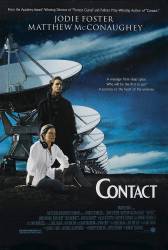Continuity mistake: There's a scene where Ellie sleeps with Palmer, then gets up quickly to go to the lab. In her haste, she departs whipping on a shirt with no bra. If she had a bra inside that tight T-shirt the contours of the cups and straps would be visible and we would see her fitting and fastening it, instead she steps outside where suddenly it appears she is now wearing a bra.
Suggested correction: I have just watched this scene again and the posting is absolutely correct. There is no bra in the T-shirt when Ellie pulls it on - we would see clear outlines of the straps and buckles if there was.
Continuity mistake: When the signal is first received, and they realize it is transmitting prime numbers, if you listen closely, the signal hits 11, starts over, but continues on up into the 30s, completely skipping all the prime numbers after 11.
Continuity mistake: If the cameras inside the Sphere won't work because of the magnetic field that is being given off by the machine, then why do the cameras on the main structure work?
Continuity mistake: When the Machine is used for the second time (with Ellie in the pod) the large outer ring is set spinning. This brings the total number of spinning rings to three. However, when video of the pod falling through the machine is played back on the TV screen, the outer ring is fixed horizontally and not moving at all. Only the two inner rings are spinning.
Continuity mistake: When Ellie arrives back from her travels, the capsule lands in a net supported from four pillars, and to decellerate effectively, both the net and capsule end up in the water. However, when we view the splashdown from a CCTV camera (Cam 03) when Ellie is in quarantine, neither the net nor the pillars are to be seen. (02:01:40 - 02:03:15)
Continuity mistake: When Ellie is in the pod and is talking to Kent, her monitor has the word "Hadden" in the top left hand corner. In subsequent shots, there is no "Hadden" on the monitor.
Continuity mistake: When Ellie is being driven through the desert she sees The Preacher with the long hair. As it cuts between them, her seat belt goes from being folded to straight to being folded again over her right shoulder.
Continuity mistake: When Ellie drives back to the observatory after hearing the first audio transmission from space, there are several shots of her holding the steering wheel with her left hand while giving instructions to the other men. In one shot you see that the wrist-watch is turned upside down: the watch face is on the inside of the arm. In the following shot of her in the car the watch face is on the outside of the arm.
Continuity mistake: During the scene in which Ellie is preparing to go in the pod through the alien machine built in Japan, she puts a small digital video camera on the side of her head (with a headphones-type headband holding it in place). During subsequent shots of her in the pod before it drops (and there are many from different angles), the camera's orientation changes noticeably from shot to shot.
Continuity mistake: When they realize the signal's counting prime numbers, watch the man in the red shirt behind Ellie when 11's being counted off. He's counting on his fingers, fills up his right hand, and moves to his left. The angle then changes to a closer shot, and his left hand is now curled up, with no numbers counted off on it at all, and he continues on his right.
Continuity mistake: Ellie tells Palmer her father died when she was nine years old. Later, when Mr. Hadden goes over her life history to impress her, the dates of her birth and her father's death indicate she was ten years old when he died.
Continuity mistake: While receiving the prime number pulses, there is a discontinuity between the pulse sequence being received and what is displayed on the monitors. As the sequence for "seven" starts (right after Ellie tells Fish to start counting the pulses), the camera switches to a computer monitor display which indicates the sequence for "seven" has already completed, and is logging the pulses of the sequence for "eleven".
Continuity mistake: When talking with Ellie on his plane Haddon's hand alternates to being on Ellie's shoulder in shots facing him to not touching her in shots behind him.





